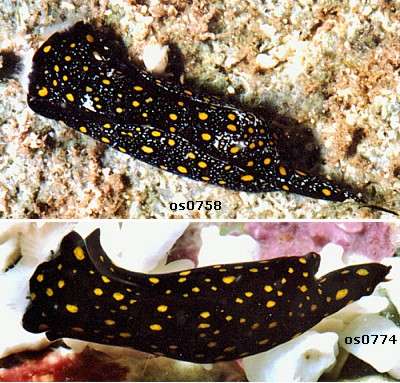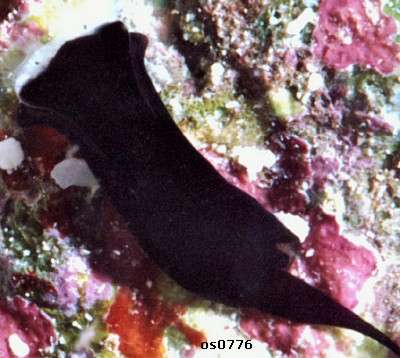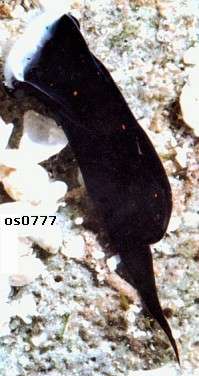Chelidonura sandrana & look-alikes
February 5, 2000
From: Lindsay Warren

Dear Bill
Many thanks for your swift response to the queries on the Polycera and Hypselodoris.
Here are some photos of the Chelidonura sandrana / tsurugensis problem group.
I found them together during the afternoon in the same shallow sand flat area on the shores of Pulau Hoga in the Tukang Besi [Indonesia - Operation Wallacea] which features a mixture of seagrass and Halimeda. Water depth was appoximately 2-3 ft deep but this area does become completely exposed at low tide. Some were mating when collected but I couldn't see which were or were not at the time.
However once in holding dishes back at our base they proceeded to form mating chains with the multi yellow spotted, sparsely orange spotted, yellow and white spotted and completely black individuals all together.
Attached are:
OS0758 - 14 mm
OS0774 - 10 mm.
OS0777 which is black with a few orange spots, L: 12 mm
OS0776 which is completely black, bar the head sensory bristle area, L: 11mm
Photos: Lindsay Warren.
Having looked at your entries for C. sandrana and C. tsurugensis our findings would seem to imply that they are different forms of the same species. I realise that you would need the specimens to confirm this and am working on getting them to you if you would like.
Looking forward to hearing your thoughts on the above.
All the best
Lindsay Warren
100014.2112@compuserve.com


Dear Lindsay,
Thanks for the photos. I certainly have found
Chelidonura sandrana ranging in colour from the very colourful to pure black. However I think your bottom two photos (0776, 0777) are probably a second species which I have in the list as Chelidonura sp. 1.. The only obvious difference is the distinctive white band across the front of the head.
I realise it is now too late to go back and see if the white banded ones joined in the mating chains with the non-banded ones, but it is certainly something worth a look next time you comne across large populations again. I have found mixed populations of these smaller species in Tanzania and east Australia so being found together, I'm afraid only confuses the issue.
I think you are right in suggesting C. sandrana and C. tsurugensis are the same but it would be good to get some photographs of Japanese species with yellow spots for comparison.
I would be interested in having a look at the specimens but if the white banded ones have not been separated from the others it may be difficult to sort out which are which.
Best wishes,
Bill Rudman.
Related messages
-
Larvae of Chelidonura sandrana
From: Johannes Faber, November 20, 2006 -
Colour form of Chelidonura sandrana
From: Gillian Elliott, March 11, 2003 -
Chelidonura sandrana colour morphs
From: Nils Anthes, January 25, 2003 -
Re: Chelidonura sandrana - feeding
From: Nils Anthes , January 18, 2003 -
Chelidonura sandrana - feeding in lab
From: Nils Anthes, January 15, 2003 -
Re: Chelidonura? from the Philippines
From: Erwin Koehler, December 3, 2002 -
Chelidonura? from the Philippines
From: Erwin Koehler, December 2, 2002 -
Chel. sandrana & C. tsurugensis mating
From: Lindsay Warren, March 29, 2001 -
Re: Chelidonura sandrana complex
From: Terry Gosliner, February 9, 2000
